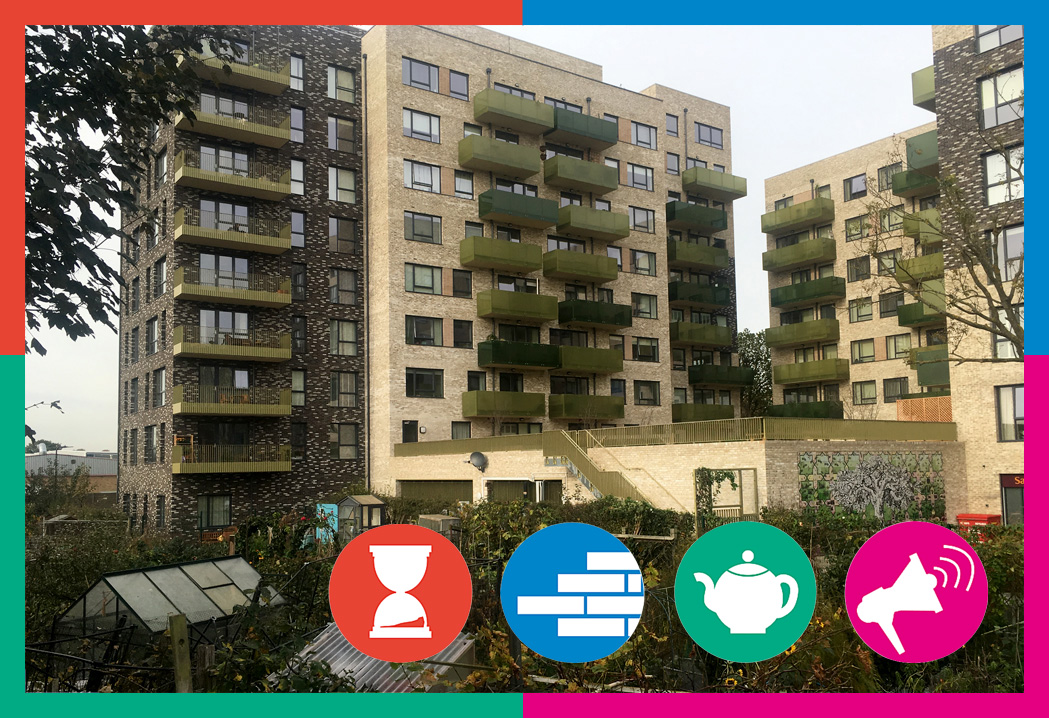About
South Acton is the largest estate in the west London borough of Ealing, with over 1,800 homes before regeneration began.
In 2015, Acton Gardens LLP, a partnership between Countryside Properties and London & Quadrant (L&Q) Housing Association, commissioned Social Life and the University of Reading to explore the social impacts of regeneration as the development progresses, and to understand how local priorities and needs can influence future phases of planning, design and management.
The project used a research framework and set of indicators for measuring the social sustainability of new housing and mixed-use developments originally developed for The Berkeley Group by Social Life, adapted for this project with the permission of The Berkeley Group.
The assessment has been repeated in 2018, and will be carried out again every 3-4 years.
Each phase of the research made recommendations for the next stages of development.
Project details
South Acton Estate is the largest in Ealing with over 1,800 homes and a variety of architectural styles including 17-storey tower blocks and low-rise brick-clad blocks. The regeneration programme will involve the redevelopment of all the existing homes on the estate, which will be replaced with 2,517 new homes, built in 21 phases between 2011 and 2024. 167 new homes in the first phase had been completed at the time of this research.
The first round of research offered a snapshot of how residents are experiencing the regeneration of the South Acton Estate at a particular point, relatively early in the process, when the first new housing has been developed at Acton Gardens (around 300 homes) and some areas of existing housing stood empty. The second round of research captured experiences when around a quarter of the proposed redevelopment was complete, when over 750 new homes were complete but much of the older estate was still standing and occupied.
Both rounds of research included a door to door survey of residents of the new and old homes on Acton Gardens, and a shorter survey of surrounding areas to show how the wider neighbourhood was faring. The sample for the survey was selected by tenure, and by location within the wider area. Interviews were arranged with local community organisations, resident activists and other local stakeholders to help contextual understanding – whenever possible these were with the same individuals over the two years. A tailored version of the Building for Life survey was used to assess how well amenities and social infrastructure were supporting local social life.
The results of both rounds of research show a strong and supportive community and overall support for the regeneration. Over time the residents living in the new blocks appear to be developing stronger social relationships and sense of belonging.
The first report, published in 2017, highlighted four main areas for Acton Gardens LLP:
• supporting residents in new housing to help them settle in the neighbourhood, meet people and take advantage of local facilities and services, in order to maintain the sense of neighbourliness that so many South Acton residents value
• ensuring that existing residents of the South Acton Estate fully understand the re-housing process
• accommodating local organisations that offer informal but very important support services to the community, without upsetting sensitive dynamics that have evolved over time
• recognising the value that residents place on their relationships with friends and neighbours in the area, and the role these play in providing social and emotional support.
The second report, published in 2019, made a further set of recommendations:
• It is important to continue to support facilities, organisations and events, both formal and informal, that bring together new and longer-standing residents. The design of new public spaces, shops and social facilities and other community facilities have a key role here, alongside existing assets that are already embedded in the neighbourhood.
• It continues to be important that services for the community are provided sensitively, in a way that respects the specific needs of the user, and to communicate with residents about facilities that are already planned and the engagement that has taken place.
• The capacity of South Acton’s residents to adapt to and embrace high levels of ethnic diversity points to resilience and adaptability. Differences in income and social class will be most easily accommodated if residents from different backgrounds are supported to develop neighbourly relationships and come to rely on one another for support. It is important to recognise the value of recent work in this area and support this into the future.
• Residents living in older homes on the estate will need social facilities and initiatives that boost wellbeing so that their quality of life is maintained throughout the regeneration. It is important to give priority to this part of the resident community.
• Attention needs to be paid to crime and safety throughout the redevelopment area, particularly in the north of the estate where there is a complex arrangement of buildings.
• More understanding is needed about the reasons for the fall in satisfaction with the regeneration programme among Acton Gardens residents after moving into their new homes, and responses should be developed to tackle this.
• Now that the project is a quarter complete Acton Gardens LLP can explore ways to make residents in the surrounding neighbourhoods feel more invested in the outcome of the regeneration programme.
• Access to public transport was highlighted as a key strength of the neighbourhood – this should be maintained when densities increase.

